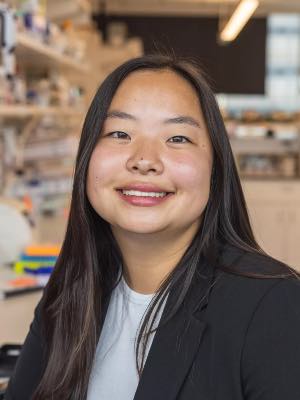Meet a Biological Sciences Master’s Student: Jasmine Jung
June 4, 2024

Jasmine Jung
Name: Jasmine Jung
UC San Diego Biological Sciences Laboratory: Associate Professor Sonya Neal
Undergraduate institution: UC San Diego (Human Biology)
(Jasmine Jung completed her master’s degree in March 2024)
Tell us about your area of focus while you were a master’s student
My research focuses on the rhomboid protein superfamily, which plays a crucial role in various cellular functions like growth factor signaling, protein quality control, mitochondrial homeostasis and parasite invasion. This superfamily consists of two main subclasses: rhomboid proteases, which are proteins that cleave misfolded membrane proteins and rhomboid pseudoprotease or catalytically inactive proteases. The degradation of misfolded proteins is essential to prevent protein aggregation, a precursor to various neurodegenerative diseases and cancers.
Rhomboid proteins are associated with two protein quality control pathways: endoplasmic reticulum associated degradation (ERAD) for degrading misfolded proteins and chaperones assisting in refolding misfolded proteins. My research focuses on further characterizing the functions of the rhomboid proteins Dfm1 and RHBDL4. Dfm1, a yeast rhomboid pseudoprotease, not only aids in misfolded membrane protein degradation through ERAD but also plays a chaperone-like role and is involved in regulating the sphingolipid biosynthesis pathway. Additionally, I have started to develop a luciferase- based assay to study the proteolytic activity of RHBDL4, a mammalian rhomboid protease associated with breast cancer progression and Alzheimer’s disease. This assay can be utilized in assessing potential RHBDL4 inhibitors for therapeutic purposes.
Why is this important?
My research provides insight into the mechanistic pathway of Dfm1, which is fundamental for understanding the diseases associated with the accumulation of misfolded membrane proteins. Additionally, understanding how Dfm1 is essential in mediating sphingolipid homeostasis can provide a potential therapeutic pathway for patients experiencing disruption of their sphingolipid balance. Furthermore, RHBDL4 has been implicated in Alzheimer’s and breast cancer. Therefore, the development of a luciferase reporter system can be used as a model drug discovery-based platform to identify drugs that can also treat these deleterious neurodegenerative diseases.
How did you get interested in this area?
I originally became interested in this area after talking with my Chem 6A TA during my freshman year. Having never explored research before, I was captivated by the Neal lab's dual focus on both cell biology and biochemistry, particularly their investigation into mechanistic pathways and their correlation with various diseases, some of which have affected several members of my family. As I continued my research journey in the Neal Lab, my growth as a scientist also continued which fueled my expanding curiosity in different research fields and different model organisms. Fortunately, my PI, former mentor and I were able to shift my focus towards translational research and working with mammalian cells over yeast cells.
While you were a master’s student, what did a typical day look like for you?
As a master’s student, a typical day involved conducting experiments for my project while trying to learn as much as possible. Given that my research primarily entailed western blots, tissue culture work and microscopy, I used the downtime I had to read various scientific papers, brainstorm new experiments and dedicate time to writing either for a scientific review or my thesis. Additionally, I would talk with my lab mates, seeking feedback on my project or expanding my understanding of the different model organisms studied in our lab. Finally, I ended my day with a workout class and a K-Drama or reality TV show.
What did you enjoy most about being a master’s student?
One of the aspects I enjoyed most about being a master’s student was the people and the independence that comes with working on your own research project. I have so much love for the Neal lab; they were incredibly supportive and played an integral role in my development as a scientist, especially Dr. Neal. Another highlight for me was brainstorming ideas for my project and reading papers to find out how I can test a new scientific question I had.
What advice do you have for someone starting out as a master’s student at UC San Diego?
My advice for someone starting out as a master’s student is to own your project! Dive deep into your topic and thoroughly research your proteins, the implicated diseases associated with your protein and even potential pathways that include your proteins. Additionally, brainstorm potential experiment ideas and confidently present them to your mentor or PI. The brainstorming, I think, is one of fun parts of the research experience besides getting the results you want!
What is your favorite type of food?
My favorite type of food is Japanese or Korean food! I also have a hobby of finding the best boba places. My favorite right now is the milk tea at Orobae!
What’s something most people don’t know about you?
One thing people don’t know about me is that I played varsity golf for all four years of high school. Competing wasn’t my favorite thing, but I love going on the course and enjoying the peacefulness.
